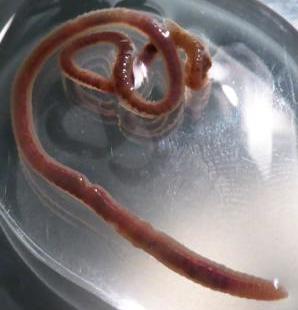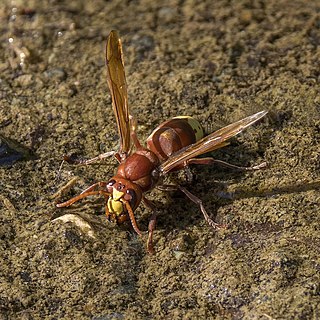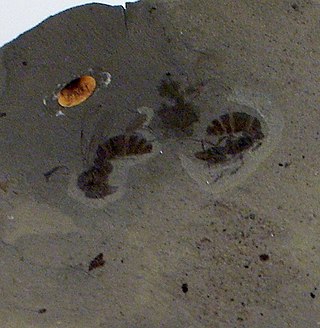
Hyacinthus is a small genus of bulbous herbs, spring-blooming perennials. They are fragrant flowering plants in the family Asparagaceae, subfamily Scilloideae and are commonly called hyacinths. The genus is native predominantly to the Eastern Mediterranean region and Afrotropical realm, although naturalized more widely.

Platycladus is a monotypic genus of evergreen coniferous trees in the cypress family Cupressaceae, containing only one species, Platycladus orientalis, also known as Chinese thuja, Oriental arborvitae, Chinese arborvitae, biota or Oriental thuja. It is native to northeastern parts of East Asia and North Asia, but is also now naturalised as an introduced species in other regions of the Asian continent.

The Lumbriculidae are a family of microdrile oligochaetes common in freshwater environments, including streams, lakes, marshes, wells and groundwater. They should not be confused with the earthworm family Lumbricidae. Many species and genera are highly endemic, mainly in Siberia and the western parts of North America. Lumbriculidae are the only family in the order Lumbriculida.

The Oriental hornet is a social insect species of the family Vespidae. It can be found in Southwest Asia, Northeast Africa, the island of Madagascar, the Middle East, Central Asia, and parts of Southern Europe. Oriental hornets have also been found in a few isolated locations such as Mexico and Chile due to human introduction. The Oriental hornet lives in seasonal colonies consisting of caste system dominated by a queen. The hornet builds its nests underground and communicates using sound vibrations. The hornet has a yellow stripe on its cuticle (exoskeleton), which can absorb sunlight to generate a small electrical potential, and this might help supply energy for digging. The adult hornet eats nectar and fruits and scavenges for insects and animal proteins to feed to its young. Because they are scavengers, the hornets may also serve as a transmitter of disease following consumption of infected plants. The hornets are a primary pest to honey bees, attacking bee colonies to obtain honey and animal proteins. The sting of an Oriental hornet can be quite painful to humans and some humans are allergic to stings.

Slipper lobsters are a family (Scyllaridae) of about 90 species of achelate crustaceans, in the Decapoda clade Reptantia, found in all warm oceans and seas. They are not true lobsters, but are more closely related to spiny lobsters and furry lobsters. Slipper lobsters are instantly recognisable by their enlarged antennae, which project forward from the head as wide plates. All the species of slipper lobsters are edible, and some, such as the Moreton Bay bug and the Balmain bug are of commercial importance.

Microbiota is a monotypic genus of evergreen coniferous shrubs in the cypress family Cupressaceae, containing only one species, Microbiota decussata. The plant is native and endemic to a limited area of the Sikhote-Alin mountains in Primorskiy Krai in the Russian Far East. Microbiota is not to be confused with the range of microorganisms of the same name. The genus name was derived from micro-, meaning "small", + Biota, the genus name for a closely related conifer, a species formerly called Biota orientalis, now renamed Platycladus orientalis.
Paramachaerodus is an extinct genus of saber-tooth cat of the subfamily Machairodontinae, which was endemic to Europe and Asia during the Middle and Late Miocene from 15 to 9 Ma. A 2022 phylogenetic analysis suggested that the genus may be polyphyletic.
Rhynchelmis is the genus of 30 species of aquatic oligochaetes from the Northern Hemisphere, with 11 species from North America and 19 from Eurasia. They are part of the family Lumbriculidae, which are among the largest of the microdriles. They are generally defined as having atria in segment X and spermathecae in segment VIII. The prostomium generally has a proboscis, from which the genus has got its name.
Bogolubovia is a genus of pterosaur from the Upper Cretaceous Rybushka Formation of Petrovsk, Saratov Oblast, Russia. It is named for Nikolai Nikolaevich Bogolubov, the paleontologist who discovered the remains in 1914. It was in 1991 assigned to the Azhdarchidae. Wellnhofer (1991) however, retained it in the Pteranodontidae. Bogolubov had initially assigned the specimen, consisting of a single partial large cervical vertebra, as a new species of Ornithostoma, O. orientalis. It was later reclassified as a species of Pteranodon, before being assigned its own genus by Lev Nesov and Alexander Yarkov in 1989. The holotype has probably been lost, but other partial remains have been referred to the genus.
Stylonuroides is a genus of prehistoric eurypterid. The genus is classified as a stylonurine but more precise classification has proven difficult, with the genus remaining classified as incertae sedis within the suborder. The genus contains two species, S. dolichopteroides from the Silurian of Ringerike, Norway and S. orientalis from the Devonian of Lake Shunet, Southern Siberia.

Tsunyidiscus is a trilobite belonging to the Suborder Eodiscina. Tsunyidiscus appeared near the end of the Lower Cambrian, during the late Atdabanian stage of geologic time and some collections suggest it may have survived into the Botomian. The genus is very small, oculate and isopypous with a narrow dome-shaped glabella and a narrow bullet-shaped pygidial axis. Thorax consists of three segments. Tsunyidiscus is the only genus currently attributed to the family Tsunyidiscidae.

Helophorus ís the only genus in the beetle family Helophoridae within the Hydrophiloidea. They are small insects, found mainly in the Holarctic region, but two or three species also live in the Afrotropical region, Central America and one in the Indomalayan region.

Agapanthus praecox is a popular garden plant around the world, especially in Mediterranean climates. It is native to the Kwa-Zulu Natal and Western Cape provinces of South Africa. Local names include agapant, bloulelie, isicakathi and ubani. Most of the cultivated plants of the genus Agapanthus are hybrids or cultivars of this species. It is divided into three subspecies: subsp.praecox, subsp. orientalis and subsp. minimus.
R. orientalis may refer to:

Ypresiomyrma is an extinct genus of ants in the subfamily Myrmeciinae that was described in 2006. There are four species described; one species is from the Isle of Fur in Denmark, two are from the McAbee Fossil Beds in British Columbia, Canada, and the fourth from the Bol’shaya Svetlovodnaya fossil site in Russia. The queens of this genus are large, the mandibles are elongated and the eyes are well developed; a stinger is also present. The behaviour of these ants would have been similar to that of extant Myrmeciinae ants, such as solitary foraging for arthropod prey and never leaving pheromone trails. The alates were poor flyers due to their size, and birds and animals most likely preyed on these ants. Ypresiomyrma is not assigned to any tribe, and is instead generally regarded as incertae sedis within Myrmeciinae. However, some authors believe Ypresiomyrma should be assigned as incertae sedis within Formicidae.
Agnostotes orientalis is a species of agnostid trilobite belonging to the genus Agnostotes. It existed during the Jiangshanian Age of the Cambrian. It is an important index fossil in biostratigraphy.

Zigrasimecia is an extinct genus of ants which existed in the Cretaceous period approximately 98 million years ago. The first specimens were collected from Burmese amber in Kachin State, 100 kilometres (62 mi) west of Myitkyina town in Myanmar. In 2013, palaeoentomologists Phillip Barden and David Grimaldi published a paper describing and naming Zigrasimecia tonsora. They described a dealate female with unusual features, notably the highly specialized mandibles. Other features include large ocelli, short scapes, 12 antennomeres, small eyes, and a clypeal margin that has a row of peg-like denticles. The genus Zigrasimecia was originally incertae sedis within Formicidae until a second species, Zigrasimecia ferox, was described in 2014, leading to its placement in the subfamily Sphecomyrminae. Later, it was considered to belong to the distinct subfamily Zigrasimeciinae.

Casaleia is an extinct genus of ants in the formicid subfamily Amblyoponinae described by Pagliano & Scaramozzino in 1990 from fossils found in Europe. The genus contains four species dating from the Eocene to Miocene, Casaleia eocenica, Casaleia inversa, Casaleia longiventris, Casaleia orientalis.
Kwangsisaurus is an extinct genus of a basal pistosauroid known from the Early or Middle Triassic of Guangxi, southern China. It contains a single species, Kwangsisaurus orientalis.

Gerontoformica is an extinct genus of stem-group ants. The genus contains thirteen described species known from Late Cretaceous fossils found in Asia and Europe. The species were described between 2004 and 2016, with a number of the species formerly being placed into the junior synonym genus Sphecomyrmodes.












